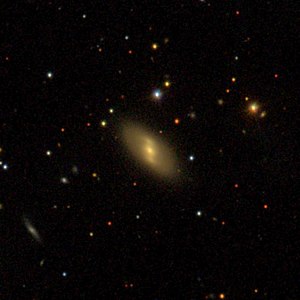NGC 7473
| Galaxy NGC 7473 |
|
|---|---|

|
|
| SDSS recording | |
| AladinLite | |
| Constellation | Pegasus |
|
Position equinox : J2000.0 , epoch : J2000.0 |
|
| Right ascension | 23 h 03 m 57.1 s |
| declination | + 30 ° 09 ′ 37 ″ |
| Appearance | |
| Morphological type | SB0 |
| Brightness (visual) | 13.7 mag |
| Brightness (B-band) | 14.7 mag |
| Angular expansion | 1.1 ′ × 0.5 ′ |
| Position angle | 45 ° |
| Surface brightness | 12.9 mag / arcmin² |
| Physical data | |
| Redshift | 0.023209 ± 0.000093 |
| Radial velocity | 6958 ± 28 km / s |
|
Stroke distance v rad / H 0 |
(320 ± 23) x 10 6 ly (98.1 ± 6.9) Mpc |
| history | |
| discovery | Albert Marth |
| Discovery date | September 6, 1863 |
| Catalog names | |
| NGC 7473 • UGC 12335 • PGC 70373 • CGCG 496-038 • MCG + 05-54-030 • 2MASX J23035707 + 3009365 • LDCE 1561 NED004 | |
NGC 7473 is a lenticular galaxy of the Hubble type SB0 in the constellation Pegasus in the northern sky . It is estimated to be 320 million light years away from the Milky Way and has a diameter of around 100,000 ly.
In the same area of the sky is the galaxy NGC 7457 .
The object was discovered by Albert Marth on September 6, 1863 .
